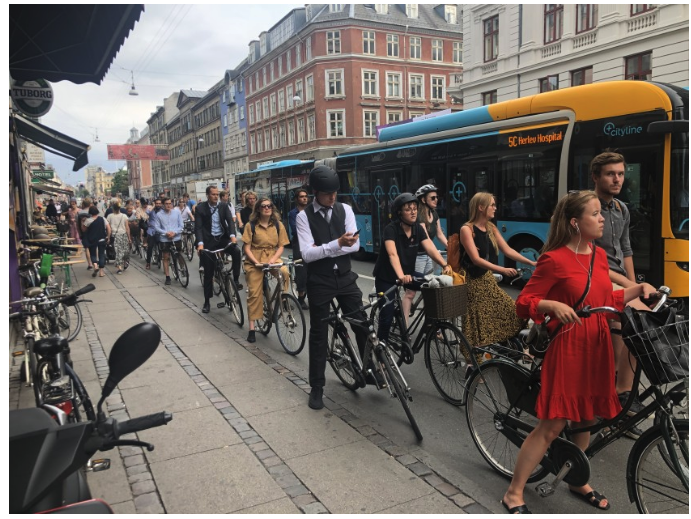Correctly pricing car use and promoting dense urban development are keys to promoting cycling
The Los Angeles Times has a gushy article–“Copenhagen has taken bicycle commuting to a whole new level,“–extolling the virtues of cycling in Copenhagen. What with a vast network of bike lines and even bike-superhighways, and a robust public commitment to making cycling a viable transportation alternative, the Danish capital is a model of how to free a city from domination by cars. Long a leader in this endeavor, Copenhagen continues to build on its success: fully 62 percent of commutes are by bike, up from 36 percent just seven years ago.

Its an impressive accomplishment, and for good reason Copenhagen stands as a model of how a prosperous Western city can consciously undertake policies that lessen its reliance on automobile transportation and reduce carbon emissions and other air pollution by making it easier and more convenient to get around by bicycle.
The LA Times chalks up Copenhagen’s success to a combination of political leadership, and the investment of about $115 million in cycling infrastructure in the past decade. Copenhagen has on-street bike lanes, dedicated bike boulevards, and even bike- and pedestrian-only bridges. Cycling has achieved social and cultural critical mass. People of all ages, different genders and social stations ride their bikes: cycling is not the exclusive province of the athletic, the young and the spandex-clad. And most everyone rides some variant of the simple, upright single-speed black city-bike. As an occasional visitor to the city, its a joy to rent a bicycle and use it as your primary means of transportation.
For those who have made the pilgrimage to Copenhagen, and come away with a romantic vision of re-making their auto-dominated city into a more bike-friendly place, there’s a lot than can be learned. While leadership and infrastructure are certainly keys to building a bike-friendly city, too many re-tellings of Copenhagen’s success–leave out some of the most important ingredients. (Aside from a reference to parking violations costs as much as $80, the LA Times article spells out none of the details about how car travel is priced in Denmark). A close look at the specific policies for taxing and pricing of cars and fuel, and promoting dense urban development are key to understanding why Copenhagen has been so successful.
Like most Western European nations, Denmark imposes heavy taxes on gasoline. The typical price of a liter of gas in Denmark today is about 10.70 Danish Kronor (DKK), which works out to about $5.70 per gallon (about US$ 0.14 per DKK and 3.78 liters per gallon). Because of higher taxes, gasoline costs roughly twice as much in Denmark as it does in the US. Cheap gasoline is a strong inducement to own and drive cars. Expensive gasoline prompts people to make very different choices, both about where to live and how to travel. (Plus the tax revenue is a vital source of funding for bike infrastructure, transit, and a range of public services).
Also, Denmark imposes a 150 percent excise tax on most new vehicle purchases. So a basic economy car which would have a retail price of say $20,000 in the US would cost upwards of $50,000 in Denmark. (The tax has been reduced from a previous level of 180 percent). Unsurprisingly, only about 29 percent of Copenhagen households own cars. Making cars and driving more expensive creates powerful incentives for people to live in places where there are good alternatives to car travel (including transit, walking and cycling), and to utilize these modes regularly.
Finally, its worth noting that the density and ownership of housing in Copenhagen is very different than in US cities. Copenhagen is relatively dense. Nearly 60 percent of households live in multi-family housing. Also, Denmark has a system of tenant-governed social housing. About 20 percent of the nation’s population lives in social housing that is constructed and governed by tenant cooperatives. Cycling is more convenient in higher density communities.
There’s a lot we can learn from the design and operation of bike lanes in Copenhagen, and the lessons about leadership and the need to make investment are real. But that’s only part of the story. Public policies that ask car owners to take greater responsibility for the cost of roads and emissions, and the conscious decision to build housing at much higher densities make cycling more attractive and feasible than car travel for many trips. As we always stress at City Observatory, the dysfunction in our transportation system stems fundamentally from charging the wrong price for roads. Stories, like this one from the Guardian, extolling the Copenhagen cycling success story shouldn’t leave out the essential role of correctly pricing cars and fuel and building dense housing.

